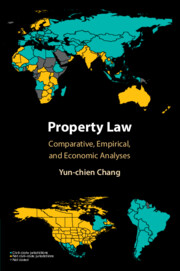Book contents
- Property Law
- Property Law
- Copyright page
- Dedication
- Contents
- Detailed Contents
- Figures
- Tables
- Citation Format
- Acknowledgments
- Abbreviations
- Introduction
- Part I Foundation
- Part II Immovable Property
- 5 Acquisitive Prescription
- 6 Building Encroachment
- 7 Co-Ownership Partition
- 8 Managing Co-ownership
- 9 Access to Landlocked Land
- Part III Movable Property
- Conclusion
- Book part
- References
- Index
8 - Managing Co-ownership
Tragedy of the Common-Ownership?
from Part II - Immovable Property
Published online by Cambridge University Press: 18 May 2023
- Property Law
- Property Law
- Copyright page
- Dedication
- Contents
- Detailed Contents
- Figures
- Tables
- Citation Format
- Acknowledgments
- Abbreviations
- Introduction
- Part I Foundation
- Part II Immovable Property
- 5 Acquisitive Prescription
- 6 Building Encroachment
- 7 Co-Ownership Partition
- 8 Managing Co-ownership
- 9 Access to Landlocked Land
- Part III Movable Property
- Conclusion
- Book part
- References
- Index
Summary
Chapter 8 first provides an overview of the stipulations regarding how things held in tenancy in common (the most common co-ownership form of property around the world) should be administered and sold, as well as co-owner agreements not to partition. Then, Chapter 8 addresses whether the several types of rules lead to underuse or overuse — that is, whether tenancy in common may lead to tragedy of the commons or anticommons. The prevalent doctrine that provides one co-owner with a unilateral power to call for partition avoids a long-term tragedy but underinvestment and underuse of co-owned resources are still likely. This chapter ends with a proposed solution to ameliorate the underinvestment and underuse problems.
Keywords
- Type
- Chapter
- Information
- Property LawComparative, Empirical, and Economic Analyses, pp. 205 - 229Publisher: Cambridge University PressPrint publication year: 2023

